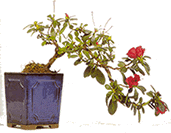Bonsai
The word bonsai is made up of two Japanese pictographs, "bon" meaning dish or bowl and "sai" meaning tree. Translated literally, this becomes "pot tree" or " large container tree". In reality, however, bonsai are meant to represent idealized images of full-grown, ancient trees and have often attained their particular shape through years of steady work, sometimes spanning several human generations. The plants that are used are young trees, about 4-6 m tall, which have branched out well just above the root system. Thought skilled pruning and gentle shaping with the help of wire, then gradually attain their desired shape.

Bonsai were first created in China over thousand years ago. The two pictographs that make up the Chinese names are the same as the Japanese ones, but the Chinese read them as "pen-jing" rather than "bon-sai".
The philosophy behind the art of bonsai is the Buddhist belief that all things on Earth - rocks, plants, animals and people - are reborn over and over again. This means that a stone may become a person, a person may become a plant in their next life, and so on. In this way, by striving for the highest possible state of spiritual perfection in one's previous incarnation, it should be possible to attain the next highest rung on the ladder of being in one's next incarnation. The principal way of achieving a state of inner peace and detachment is through regular meditating is to spend hours quietly gazing at a tree growing in the wild. It is thus quite possible that bonsai trees were first developed for reasons of convenience, while the creation of miniature trees in bowls also offered the opportunity to collect different types and shapes of trees.
